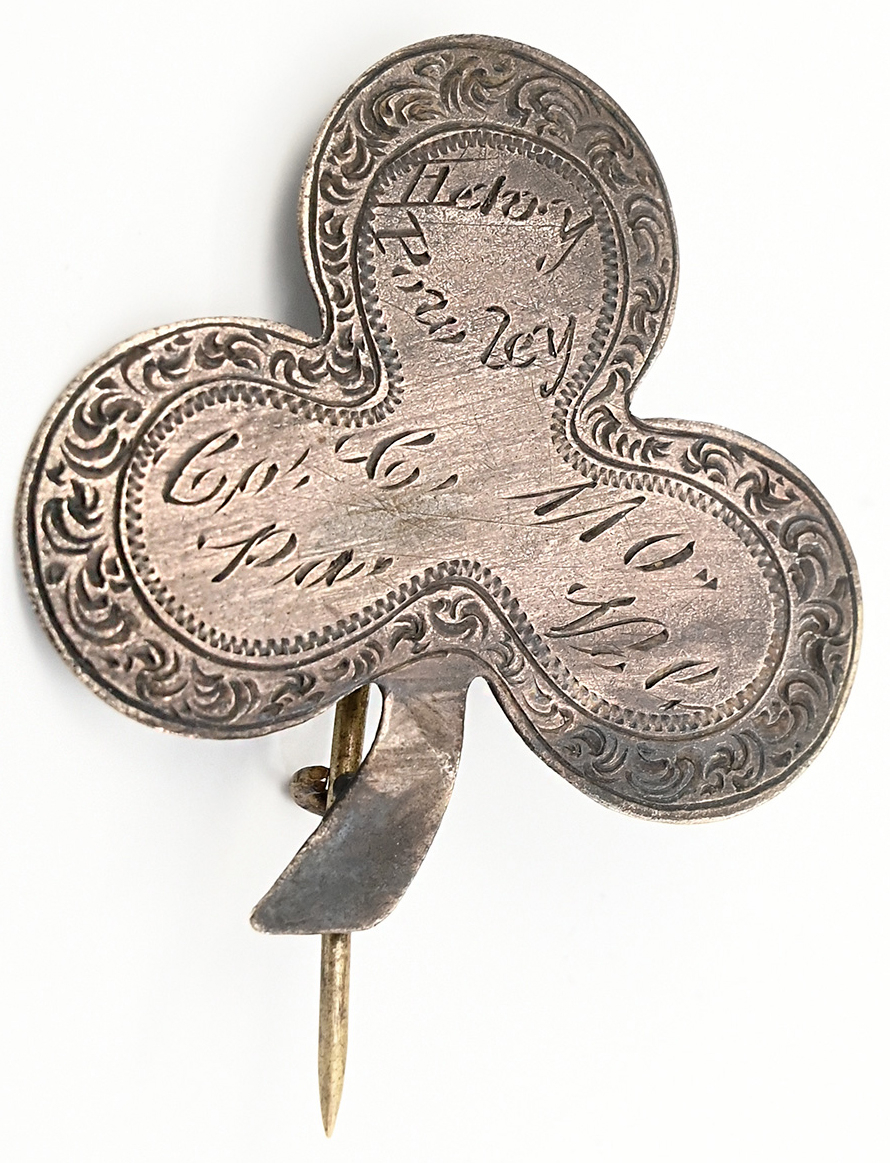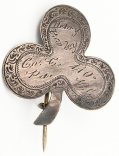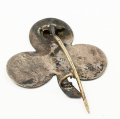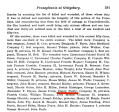site search
online catalog
INSCRIBED SECOND CORPS BADGE OF HENRY POWLEY, 110th PENNSYLVANIA, WOUNDED AT GETTYSBURG ON JULY 2 IN THE WHEATFIELD

$3,650.00 SOLD
Quantity Available: None
Item Code: 490-2631
This is a jeweler-made and inscribed silver Second Corps badge with its long T-bar pin still in place on the reverse. The badge is the regulation trefoil shape designating the Second Corps with a curving stem at bottom. The face has a double-line outer border in the middle of which run curving and swirling lines giving the impression of floral scrolls and along the inner line runs a narrow ric-rac border line as well. The top lobe is engraved in a loose script, “Henry / Powley” with “Co. C 110’’ / Pa. Vol.” engraved across the lower center of the badge in a slight arc. Henry L. Powley served with in Company C of the 110th Pennsylvania for its entire term of service and was wounded on July 2, 1863, at Gettysburg while fighting with the regiment as part of DeTrobriand’s brigade in the Wheatfield. His name appears on the regimental plaque on the Pennsylvania state monument at Gettysburg, which lists men present on the field, and he appears among those wounded in the regimental casualty list published in Pennsylvania at Gettysburg by the state monuments’ commission.
Powley mustered into Co. C of the 110th on 10/24/61 as a private to serve three years. He was listed as age 18 (more a matter of bookkeeping than fact: he seems to have been 17,) standing 5’5” with fair complexion, light hair, and gray eyes. He is credited to Blair County, but another document gives his residence as Dauphin. He reenlisted as a veteran in January 1864 and was discharged with the regiment at Washington on 6/28/65. The 110th was a fighting regiment, losing 7 officers and 111 enlisted men killed or mortally wounded in battle, in addition to scores wounded or maimed for life. It served in the Third Army Corps, Army of the Potomac from June 1862 and in the Second Army Corps from March 1864 when the Third Corps was broken up.
The regiment was formally organized November 1861 at Harrisburg and in January 1862 joined Banks’s Corps in Maryland. In March it moved to Winchester and on March 23 as part of Tyler’s Brigade of Shields’ Division, played a key part in defeating Jackson at Kernstown. They saw action again at Port Republic, Second Bull Run, Fredericksburg, and Chancellorsville. Casualties at Fredericksburg reduced the regiment to about 300 fighting men who were then consolidated into just six companies. Chancellorsville reduced their number further: they entered the field at Gettysburg with a fighting strength of just 152.
On July 2 the regiment held the right of DeTrobriand’s brigade on Stony Hill in the fighting at the Wheatfield. Fighting alongside the 5th Michigan, they helped repulse the initial attacks of Anderson’s Georgia Brigade, facing the 9th Georgia and 8th Georgia in much of the combat. Briefly reinforced by the brigades of Tilton and Sweitzer, they held their ground even after those reinforcements withdrew in the face of Kershaw’s attack from their right, eventually pulled back to the middle of Wheatfield, and then joined in a brief countercharge in attempt hold back Anderson’s renewed attack. The regiment lost 8 killed and 45 wounded in the fighting, about 34 percent. Powley is listed among the wounded. A secondary source states the wound was in the right leg, above the ankle.
The regiment took part in the army’s move south that Fall, seeing It moved southward with the army, seeing action at Kelly’s Ford in November and Mine Run in December. Whether Powley’s wound was serious enough to sideline him for those campaigns is unclear, but he reenlisted as a veteran on January 4, 1864, at Brandy Station. The regiment took the field again in May, fighting at the Wilderness, Spottsylvania, the Po river, the North Anna, Totopotomoy, Shady Grove Church, Cold Harbor and the Chickahominy. It took part in the first assaults on Petersburg and the action at the Weldon railroad, Deep Bottom, Hatcher's run, in the raid on the Richmond & Danville railroad. Its winter quarters were at “Fort Hell,” and on March 25, 1865, the regiment helped repel the attack on Fort Stedman. It then took part in the pursuit of Lee, seeing its last combat at Sailor's creek, where it lost 3 killed and 6 wounded according to CWData, and was mustered out at Washington on June 28, 1865, with Powley still in its ranks.
Powley returned to civilian life in Pennsylvania and we find him in 1870 working as a “laborer,” which apparently made the army seem not so bad. He signed up for a five-year stint in the regular army in January 1870, serving in the 6th U.S. Cavalry from 1870 to 1875, when he was discharged at Fort Dodge, Kansas. He returned to Pennsylvania and took a job working the Pennsylvania Railroad blacksmith shop in Juniata, where he married in 1876. After retirement he moved west with his wife and died at his home in Independence, Wisconsin, at age 84 on Sept. 23, 1926, survived by his wife, two daughters, and a foster son. He was interred in Hutchison’s Cemetery at Greenwood, Pennsylvania.
This is a very nicely looking, inscribed badge worn by a soldier with a good combat record who was wounded the most famous battle of the war. In this listing we also show a famous Civil War photograph taken of Company C 110th Pennsylvania while in the Third Corps just before Chancellorsville. This was Powley’s company throughout the war. He is almost certainly one of the men in the ranks. [sr] [ph:L]
~~~~~~~~~~~~~~~~~~~~~~~~~~~~~~~~~~~
THIS ITEM, AS WITH ALL OTHER ITEMS AVAILABLE ON OUR WEB SITE,
MAY BE PURCHASED THROUGH OUR LAYAWAY PROGRAM.
CLICK HERE FOR OUR POLICIES AND TERMS.
THANK YOU!
Inquire About INSCRIBED SECOND CORPS BADGE OF HENRY POWLEY, 110th PENNSYLVANIA, WOUNDED AT GETTYSBURG ON JULY 2 IN THE WHEATFIELD
For inquiries, please email us at [email protected]
Most Popular
Historical Firearms Stolen From The National Civil War Museum In Harrisburg, Pa »
Theft From Gravesite Of Gen. John Reynolds »
Cavalry Carbine Sling Swivel »
Fine Condition Brass Infantry Bugle Insignia »
featured item
WORLD WAR TWO / KOREA UNITED STATES MARINE CORPS OFFICER’S MAMALUKE SWORD
The drawn sword meas. approx. 36.00 inches long. The blade itself meas. approx. 31.00 inches long x 0.75 of an inch wide at the ricasso. It has a central fuller that starts just above the ricasso and runs for approx. 27.00 inches. The blade surface… (2021-944). Learn More »






